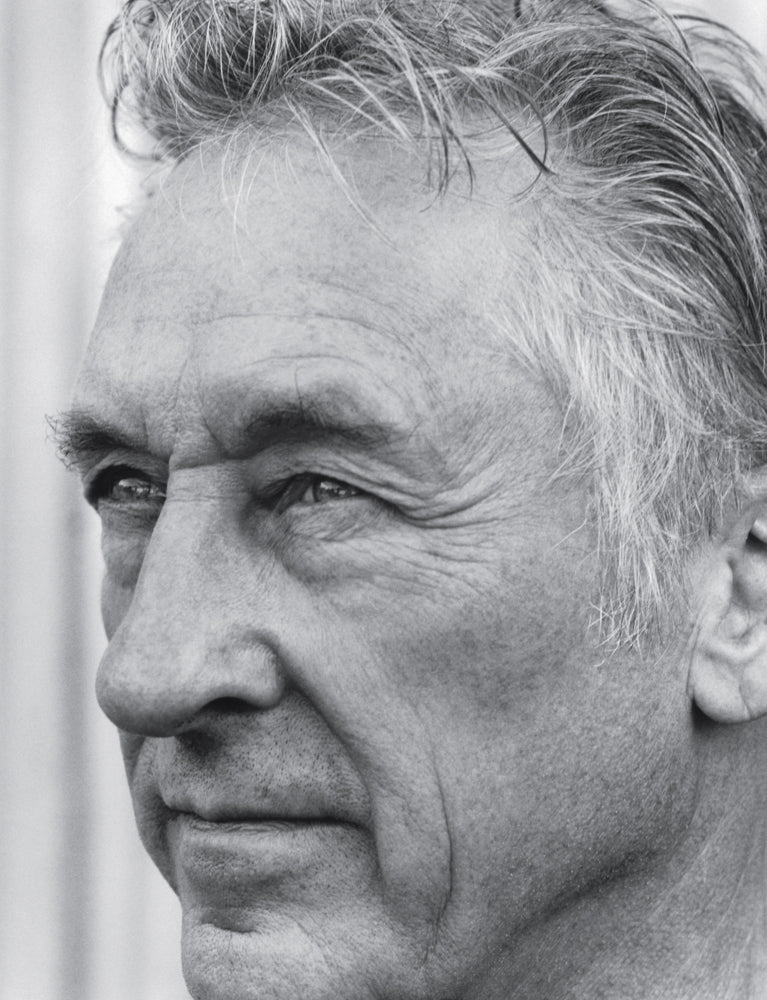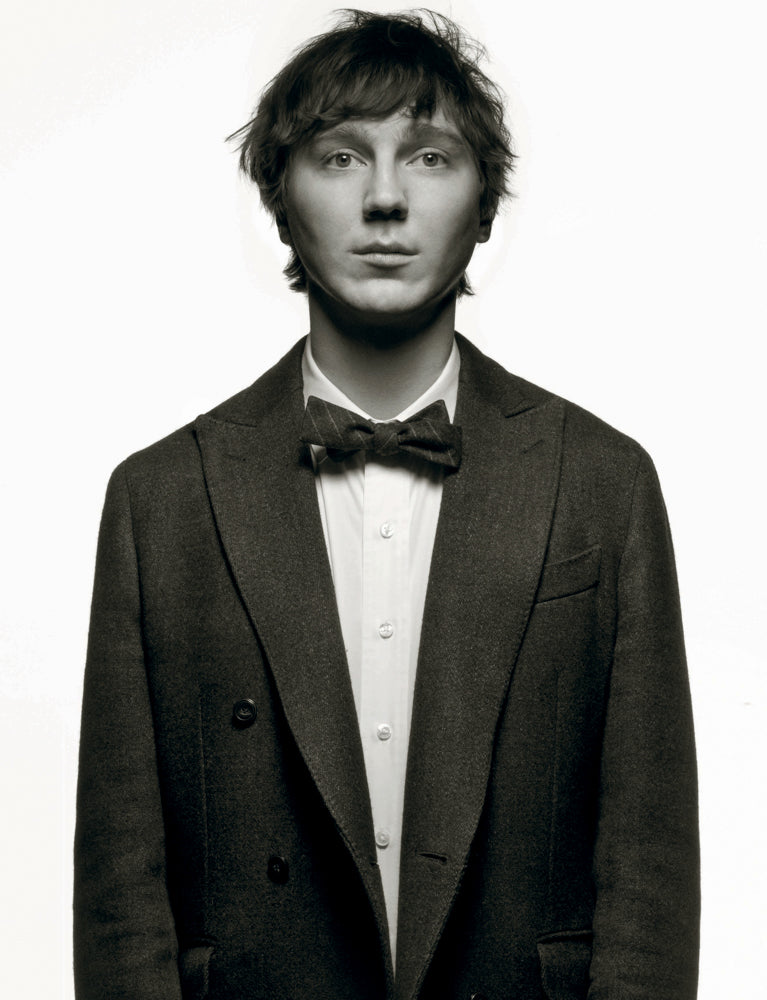
Ed Ruscha Looks Out
ED RUSCHA LOOKS OUT

Ed Ruscha is not a man of our digital time. He does not have a smartphone, for instance. He prefers, instead, an old-school, thin, flip-open-the-lid-with-your-thumb model. He’s pulling it out right now, even as he looks over our own somewhat aging iPhone, Voice Memo app running, recording him. “That’s my voice print?” he asks, observing the map of sound waves that, yes, are his. Ruscha himself did not google anything on the road this morning. A personal data device will not interrupt a conversation to remind him that he has, say, a conference on his work at the Centre Georges Pompidou in Paris in March, or where he has to be at lunch. There will be no scrolling through microscaled digitized images of his work — decades of it: paintings, photographs, books, drawings, prints, and, during early years, film.
“I still like paper. I’m constantly writing things on paper,” he says, in a cavernous warehouse space dedicated to almost entirely one function — the housing, for ready access, of racks and racks and racks of books. Apple that. “And, as an artist, I’m still locked into these traditional techniques,” he says, finishing his thought.
This is not to say that he hasn't had more than a passing interest in what may transpire under certain conditions when it comes to communication, in what happens when the verbal — a word, snippet, sentence — is also visual. “I like the idea of a word becoming a picture, almost leaving its body, then coming back and becoming a word again,” Ruscha has been quoted as saying.
Initially, Ruscha selected words because they sounded funny; he later progressed into the more enigmatic. The, or is it T and he, painted simply, the foreground an idealized, snow-tinged mountain peak behind those three mundane letters in The Mountain (1998). Honey….I Twisted Through More Damned Traffic Today (1984), with its brush-stroked sky that drifts into white as it descends the canvas. Wen Out For Cigrets N Never Came Back (1985) — the text up close to us, as if stenciled on glass, with an air-brushed, blurred-focus grid of city lights at night behind. Sin set up big and large and audacious against the clouds of heaven, in Sin—Without (1991). Or did we misunderstand — is it S and in? Never mind.



When queried, Ruscha typically dodges assigning a meaning to the letters that are often his subjects—it’s your call, is most likely his response, as he declines to reveal anything. But his process is anything but cavalier. “Premeditated,” is the way he puts it — a final articulation, meticulously planned in drawings that detail subject and scale. Then Ruscha steps back, out of frame — disappears. Interpretation is what’s in your head. He is the straight man, the deadpan partner of the comedy duo, who constructs the set-up, then hands it over to the glamour guy to deliver the punch line, pick up the glory. He would rather talk about something or someone else. Ed Ruscha is not a man of the selfie.
He slips in, a sliver late, deliberately arriving unnoticed at a friend’s book signing at the Los Angeles County Museum of Art. (An institution that Ruscha once, famously, painted as a high-wide shot, as realistically as an architectural diagram, with one small exception: the building was on fire. To be fair, he also lit a restaurant in Norms, La Cienega, on Fire (1964). And a Standard station, too — Burning Gas Station (1965–66). His interest had been “to put speed into a flat, static picture,” he told the critic Kristine McKenna.)
In Venice, CA, where Ruscha had a studio for decades, the route for his dog walk was not that trendy wet dream, Abbot Kinney Boulevard, but Electric Avenue, a thin backstreet, with bungalows hedged off from the road on one side, warehouses and parking lots on the other.
Since the early sixties, when artist John Altoon paid him to institute lettering on several Altoon canvases, Ruscha’s been as content in the wingman position as solo artist. In 2003, though he held international recognition and recompense, Ruscha was still interested in collaboration with another man of letters, Raymond Pettibon, producing two small-edition lithographs, The End and The Holy Bible. The two men switched up who would contribute imagery and text in each. By 2009, his anti-retrospective gambit having failed several times (I Don’t Want No Retro Spective was the cover art for a major exhibition at the San Francisco Museum of Art in 1982, which traveled to the Whitney in New York), Ruscha forwent ownership of the word entirely, offsetting Jack Kerouac’s prose with photographs in a limited-edition issue of On the Road. Published by Steidl and his gallery, Gagosian, Ruscha populated the book with images he found or commissioned from other lensmen, in addition to his own.



The books he printed himself, seventeen of them, during the sixties and seventies — Twentysix Gasoline Stations (1963), Some Los Angeles Apartments (1965), Real Estate Opportunities (1970), Every Building on the Sunset Strip (1966) — denuded the conventions of the artist’s book, alleviating it of its preciousness, democratizing its affordability decades before digital made access to imagery ubiquitous. He also took out, or appeared to exorcise, the artist’s hand entirely. The photographs that filled each book could involve fastidious testing and planning, but the imagery they captured was ascribed no hierarchy. Ruscha was not determining what was aesthetically meritorious inside the frame. He was only documenting what existed, ready-mades. He was an anthropologist. He was a recorder. After the new millennium, he reshot Hollywood Boulevard, which he first photographed in 1973, and coupled old and new images for the artist’s book Then and Now.
His predisposition to revisit includes what is perhaps his most identifiable subject — beyond his elusive words — the Hollywood sign. The affinity began not as a dreamy signifier but as a thermometer of how bad the smog was beyond his Western Boulevard studio. Could he see it or not? Ruscha has examined — correction: continues to examine — the emblem from front and back, in paint and airbrush and the ink of the lithograph. He recently configured its famous letters, so protected in reality, as tilted, crumpled, fallen, in a dingy, dirty sky in Landmark Decay (2006). Ruscha is a tracker of the sometimes snake-fast, sometimes glacially slow creep of culture, a watcher of the ‘now’ — the slip of change not yet interpreted by academics as history — a keeper of data in his head. The figures for Los Angeles’s population were on his radar when he moved here, as is its present conveyor-belt growth.
In 1956, Ruscha drove the roads that vein America from Oklahoma to Los Angeles, to pursue life as an artist. The vocation promised little glamour and less money. He attended Chouinard Art Institute, where the prevailing ethos was Abstract Expressionism. The “Expression” referred not to the final piece the viewer saw but the spontaneous gesture of the artist as he or she painted it, an impulse of the internal that the work derived from. The splats of Pollack. Rothko’s emotive color fields. It’s almost impossible to think of Ruscha, so quietly private, adhering to an art movement that exposed so much emotion. He rebuffed it for a simpler reason: Abstract Expressionism was being done. Influenced by Jasper Johns, Ruscha turned toward the ordinary object coupled with its abstraction. Very early on, he considered how to bring books, type into paintings. And, in 1961, with those four letters, Boss, words became the subject.









Given the visibility of Pop, today’s generation might think that Ruscha ran with an inner circle that held a similar outlook. That wasn’t his daily milieu. He saw Roy Lichtenstein’s paintings of comics in 1961 on a trip through New York, but both Lichtenstein and Warhol were based there, not in LA. Ruscha’s friend Joe Goode was employing a Pop sensibility in 1961 and ’62 — an actual milk bottle on the gallery floor, placed before a monochromatic painting — but in 1962, when Ruscha painted the words Heavy Industry, in a simple serif font across an almost square canvas, shading depth into an almost singular brown background, his contemporaries at his gallery, Ferus, were in the throes of birthing the Finish Fetish and Light and Space movements. At Chouinard, Ruscha’s break with Abstract Expressionism so incensed a teacher, the teacher burned a piece.
More than a half century of experimentation later, Ruscha has so clarified the articulation of the simultaneous glimpse of word and picture — his invented language of art as pervasive as the culture it records — that his realization of word and picture might seem obvious. So not so. It’s easy to forget that it’s not Warhol, art about art; though it has elements of conceptual art, it breaks from that school, too. The iconography might be ready-mades, a street, a gas station, a quote from Shakespeare, words from a technical manual, but it doesn’t fetishize them. Pushed, Ruscha has described the work as abstract.


For the viewer, the simultaneous experience of the background, the visual, and the verbal engages right and left sides of the brain and ruptures preconceptions. Like the man, it is deceptively simple. In person, Ruscha is sure but relaxed, easy. Better versed in literary forms than most postgraduate English students, he’s low-key in his dis- cussion of them and doesn’t partake in the incomprehensible artspeak that, today, is a source of status in the art trade. Edging toward his late seventies, Ruscha regularly makes the drive from Los Angeles to his second home in the desert — an “elixir,” as he describes the place, an expanse of “solitude versus the noise of the city.”
The city. Ruscha’s utilization of Los Angeles as subject is so extensive that he is often labeled the Los Angeles artist, as if his art would not have occurred in another metropolis. In 1966, he countered that he would have done what he does anywhere. We’ll give him that.
On the wall of the reception area in Ruscha’s current studio complex in Culver City, amongst his extensive collection of other artists’ work installed on the walls, is a purchase by Ruscha’s brother Paul, a photographer, who evidently has a thing for picking up reproductions online. In this case, a replication of the Andrew Wyeth classic Christina’s World — a woman lies in a field, her back to us, gazing at a farmhouse in the distance. Next to it is a newspaper clipping that Ruscha pulled, titling it, in handwriting, “Christina’s World.” Its salient feature — a photograph by Matthew Staver shot under the aegis of Bloomberg News for a story about a construction boom and bust, which captures a vignette taking place in the once unmarred open space of Colorado. In the background is a freshly built home; up close, two construction workers kneel as they finish a separate building’s concrete floor. Its composition is so similar to Wyeth’s, the time and worlds so different — a microcosm-of-the-mundane slyly capturing changing America. Ed Ruscha looks out.




